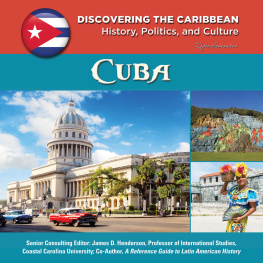Published by the University of Pittsburgh Press, Pittsburgh, Pa., 15260
Copyright 2018, University of Pittsburgh Press
All rights reserved
Manufactured in the United States of America
Printed on acid-free paper
10 9 8 7 6 5 4 3 2 1
Cataloging-in-Publication data is available from the Library of Congress
ISBN 13: 978-0-8229-6549-7
ISBN 10: 0-8229-6549-6
Cover art: Havana building restored and old. Leah Simpson / Alamy Stock Photo
Cover design: Joel W. Coggins
ISBN-13: 978-0-8229-8641-6 (electronic)
We dedicate this book to our colleague and co-author, Kevin Morrison, whose path ended too soon. He taught us not only through his scholarship, but also through his courage and humanity.
INTRODUCTION
REFORMING COMMUNISM IN COMPARATIVE PERSPECTIVE
JORGE PREZ-LPEZ AND SCOTT MORGENSTERN, WITH JEROME BRANCHE
Although Cuban officials avoid the word reform, Cuba has been updating or modernizing its socioeconomic development model or on the brink of making significant changes for several decades. Cuba is a country of contrasts and contradictions that feed internal and external conflicts. The surprising December 17, 2014, announcement by President Barack Obama and President Ral Castro about a new direction for U.S.Cuban relations, followed by the formal reestablishment of diplomatic relations on July 1, 2015, and the reciprocal reopening of embassies in Washington and Havana in July and August 2015, respectively, confirmed Cubas ongoing updating process. Recent political changes in the United States, however, have put into question the future of the direction of the bilateral relations and exposed, again, how dependent Cuban politics are on its giant neighbor. We will also set out in this volume how Cuban economic policies have been dependent on their benefactors; support by the Soviet Union and Venezuela sustained Cuba for many decades, and their respective decay (in the late 1980s and the 2010s) forced Cuba to consider changes. As we complete this manuscript, over a year since the Trump administration took office, and just as Ral Castro stepped down from his presidential post, it is far from clear whether the momentum towards reform initiated around 2010 will continue, stall, or reverse. This suggests, overall, that reform is fragile and dependent on both domestic and international actors and contexts.
At roughly the time that Fidel Castro passed the presidential torch to his brother Ral (2006), Venezuelas support of Cuba waned, and the island initiated a tentative yet important set of changes. Today Cubans can open small businesses, travel abroad, more easily access the internet, and purchase cell phones, microwave ovens, (prohibitively expensive) new cars, and even homes. Important steps aimed at influencing the external environment by attracting foreign investment were the creation of the Mariel Special Development Zone (ZED Mariel) in November 2013 and the approval of a new foreign investment law in March 2014, offering protections and incentives to foreign capital to participate in updating the Cuban economic model. The evolving relationship with the United States could accelerate many of these trends, in part by bringing more Americans and more American goods into Cuba. Of course these changes in economics and international relations also influence society, moving the needle on social issues such race, youth, and gender, which in turn is reflected in the arts.
Shortly before the historic December 2014 coordinated statements by Presidents Obama and Castro announcing the intention of the United States and Cuba to work toward normalization of relations, many of the authors in this book met at the University of Pittsburgh at a conference to examine Cubas internal reforms and their external influences within a comparative framework. The goal of the conference was to draw on experiences from different parts of the world to explore Cubas reform process and potential directions and challenges for future changes. This volume is the result of our discussions, supplemented with contributions from other scholars who were not in attendance but whose work spoke to issues that were relevant to the project.
Our goal in this volume is to move beyond studies that focus on a single reform theme, such as economic development. We have instead considered potential reforms in multiple issue areas, which we have grouped under the themes of economics, politics, and society. In so doing, we have crossed traditional lines, by including both social scientists and scholars from the humanities in order to consider reforms from diverse academic perspectives. While this has sacrificed some unity in methodologysome chapters use the comparative framework less explicitly than othersthere are substantial gains from providing broader perspectives.
The overall goal of the book is to discuss and analyze concerns about reform in Cuba, and where possible to draw lessons from a comparative context. To be most useful, the comparisons require a detailed description of the Cuban case itself. This chapter, therefore, focuses specifically on Cuba, providing a general outline of the historical and ongoingthough generally hesitantreforms on the island. Using a comparative framework, a thesis for this book is that reforms in Cuba and elsewhere take a nonlinear path without a predetermined end, because the directions are contingent on changing factors such as the international climate and relations, economic exigencies, social structures, historical precedent, and political maneuvering. At the end of this chapter we summarize the books comparative chapters, which show the variety of winding paths and highlight the lack of a teleological result of reforms around the world. With an eye on how the countries analyzed relate to Cuba, the comparative chapters also examine the factors that have led the different countries along their particular circuitous (and not always successful) paths with respect to reform within the areas of economics, politics, and society. The comparative context is particularly important for the first two of these areas, where the authors address issues such as the efficacy and effectiveness of social security policy, investment policies, and the sustainability of democracy. The goal of these chapters is to offer lessons for reform both generally and for Cuba, and to outline potential directions based on policy options and sources of pressure on the system. The other chapters look inward, considering how Cubas society must face challenges in terms of race and domestic violence.
CONTRADICTIONS AND THE NEED FOR REFORM
In spite of being an island nation of just 11 million people, Cuba has had a big-nation foreign policy impact. The Cuban model has been an inspirationfrom both positive and negative perspectivesfor social movements, political leaders, and cultural expressionists around the world. Leftist groups have drawn hope from Cubas advances in public health and education, as well as the countrys ability to survive in the face of U.S. animosity. Opponents of the regime, meanwhile, point to violations of human, civil, and political rights, as well as the stagnation of the economy and decay of infrastructure. The highly visible and eccentric transportation system provides a microcosmic view of the inconsistencies that abound in the island. Alongside luxury tourism buses and modern airports are the ubiquitous U.S. cars from the 1950s and Soviet Ladas from the 1980s, as well as nineteenth-century horse-drawn wagons, especially outside Havana.












